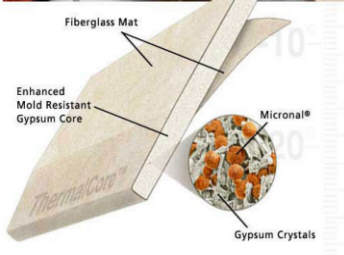
Search
The Renewable Energy site for Do-It-Yourselfers
Comparing Phase
Change Drywall to Regular Drywall for Heat Storage
| National Gypsum has announced that they plan to produce a phase
change drywall product that is called
ThermalCORE. The phase change material is Micronal,
which is mixed in with the regular gypsum. The Micronal is wax
type phase change material with a melting point of 73F.
The boards are faced with a fiberglass mat (to make up for strength
lost to the phase change material?).
The basic characteristics oft he material are listed as:
- Phase change (melting) temperature 73F.
- Heat stored or released at the phase change is 22 BTU/sqft.
- Weight of the material in the half inch thickness is 2.1 lb/sqft.
|
|
The material
properties
for regular drywall are listed as:
Weight of 2.0 lb/sqft for half inch
material.
Specific Heat 0.26 BTU/lb-F
Comparing Heat Storage
If you think of the useful heat
storage range as extending from 68F up 85F, then how does these three materials
compare on heat stored per sqft?
1 - Half inch phase change drywall:
Heat stored = (85F-68F)*(0.26
BTU/lb-F)(2 lbs/sf) + (22 BTU/sf) = 8.9 + 22 = 31 BTU/sf
This is assuming that in going
from 68F up to 85F, the phase change drywall stores heat just as normal
drywall does for the temperature change plus the heat storage associated
with the phase change. Most of this heat gain and release will occur
at the 73F melting temperature of the wax.
2 - Half in regular drywall:
Heat stored = (85F-68F)*(0.26
BTU/lb-F)(2 lbs/sf) = 9 BTU/sf
3 - Two sheets of regular 5/8ths
drywall (that is, using two sheets of 5/8 inch stacked to gain mass):
Heat stored = (85F - 68f)*(0.26
BTU/lb-F)*(2.5 lb/sf*2sheets) = 22 BTU/sf
So, over the 68F to 85F range, the
phase change drywall stores and releases more than 3 times as much heat as
conventional half in drywall.
If you stack two sheets of the heavy
5/8 inch thick drywall together (as is done sometimes to increase thermal mass),
then the half inch phase change drywall still stores about 1.5 times as much
heat.
The other nice thing about the phase
change drywall is that it stores and releases most of the heat at a nearly
constant temperature, which is probably more comfortable.
So (tentatively), this looks like a
promising material if things like cost and durability don't get in the way.
Gary June 13, 2010

